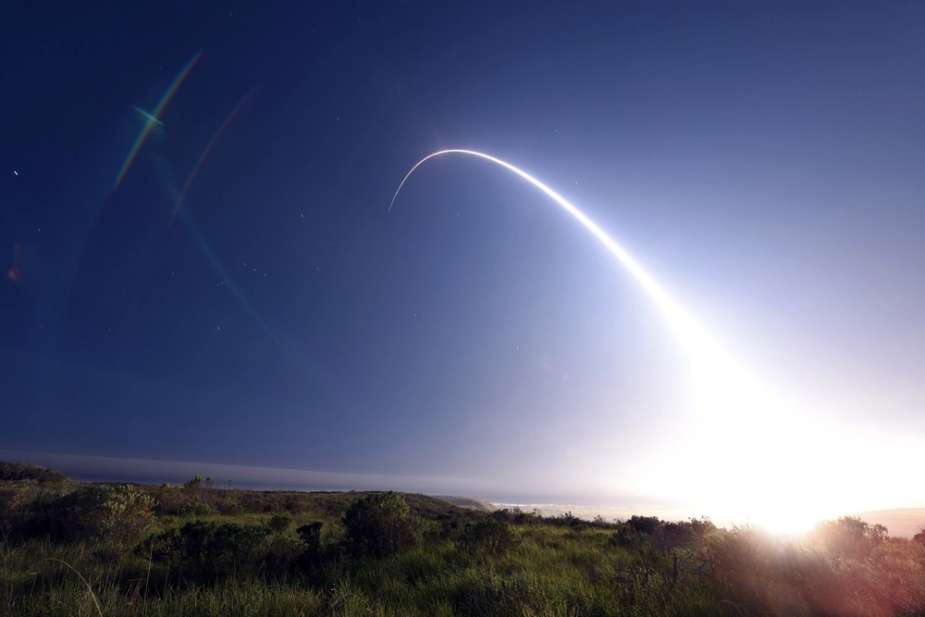Breaking news
US set to launch unarmed Minuteman III ICBM intercontinental missile.
According to the Santa Barbara Independent on October 25, 2023, the US Air Force Global Strike Command is scheduled to conduct an operational test launch of an unarmed LGM-30G Minuteman III intercontinental ballistic missile (ICBM) on October 31, 2023. The primary objective of this launch is to demonstrate the readiness of US nuclear forces and reinforce confidence in the effectiveness of the nation's nuclear deterrent, as stated by Air Force Global Strike Command.
Follow Army Recognition on Google News at this link

An unarmed Minuteman III intercontinental ballistic missile launches during an operational test at Vandenberg Air Force base in 2016 (Picture source: US DoD)
It is important to note that this test was pre-scheduled and is a routine part of a sequence of test launches. Its purpose is to validate and affirm the effectiveness, readiness, and precision of the Minuteman III intercontinental ballistic missile. In accordance with established protocols, the United States has adhered to international agreements by sending a pre-launch notification as per the Hague Code of Conduct. Additionally, the Russian government has been informed in advance, in compliance with bilateral obligations between the two nations.
The LGM-30G Minuteman III intercontinental ballistic missile is a fundamental element of the United States' strategic deterrent forces, under the oversight of the Air Force Global Strike Command. In its nomenclature, "L" designates a silo-launched missile, "G" signifies surface attack capability, "M" stands for guided missile, "30" represents its association with the Minuteman series, and the "G" appended to "30" indicates that it pertains to the current Minuteman III model.
The Minuteman III is a strategic weapon system that employs an intercontinental ballistic missile capable of covering vast distances. These missiles are dispersed in fortified silos to enhance their protection against potential attacks. They are linked to an underground launch control center via a network of hardened cables. Launch crews, comprised of two officers, maintain a continuous state of alert within these launch control centers.
This system includes an array of communication mechanisms that ensure the President and Secretary of Defense maintain highly reliable and virtually instantaneous direct contact with each launch crew. In cases where communication is disrupted between the launch control center and remote missile launch facilities, specially configured E-6B airborne launch control center aircraft assume command and control of the isolated missile or missiles. These aircraft are manned by fully qualified airborne missile combat crews prepared to execute the US President's directives.
The Minuteman weapon system's origins date back to the late 1950s, with the deployment of the Minuteman I in the early 1960s. Both the missile and its basing components incorporated substantial advancements, distinguishing them from the earlier generation of liquid-fueled, remotely-controlled ICBMs. Minuteman missiles have consistently provided a quick-reacting, inertially guided, highly survivable element within America's strategic deterrent program. The maintenance strategy of Minuteman relies on high reliability and a "remove and replace" approach, which has yielded an almost 100 percent alert rate.
Over the years, the Minuteman system has been subject to continuous modernization efforts, leading to the development of new missile versions, expanded targeting options, improved accuracy, and heightened survivability. The contemporary Minuteman weapon system stands as a testament to nearly six decades of continuous enhancement.
The existing ICBM force consists of 400 Minuteman III missiles distributed among the 90th Missile Wing at F.E. Warren Air Force Base, Wyoming; the 341st Missile Wing at Malmstrom Air Force Base, Montana; and the 91st Missile Wing at Minot Air Force Base, North Dakota.
The Minuteman III serves as an intercontinental ballistic missile and is produced by the Boeing Co. This formidable weapon relies on three solid-propellant rocket motors for its propulsion, with the first stage being the ATK refurbished M55A1, the second stage the ATK refurbished SR-19, and the third stage the ATK refurbished SR-73. It possesses a formidable thrust, with the first stage capable of exerting 203,158 pounds (903,691 Newtons), the second stage 60,793 pounds (270,421 N), and the third stage 35,086 pounds (156,070 N).
In terms of weight, the Minuteman III weighs 79,432 pounds (36,030 kg), and it has a diameter of 5.5 feet (1.67 m). Its range extends over 6,000 miles (5,218 nautical miles or 9,497 km), and it can attain speeds of approximately 15,000 mph (equivalent to Mach 23 or 24,000 km/h) at burnout. The missile boasts a ceiling of 700 miles (1,120 km). It was deployed in June 1970, and production ceased in December 1978. As of now, the active force comprises 400 Minuteman III missiles, with no reserves in the inventory and none held by the Air National Guard.

An Air Force Global Strike Command unarmed Minuteman III intercontinental ballistic missile launches during an operational test at Vandenberg Air Force Base in 2020 (Picture source: US DoD)



















